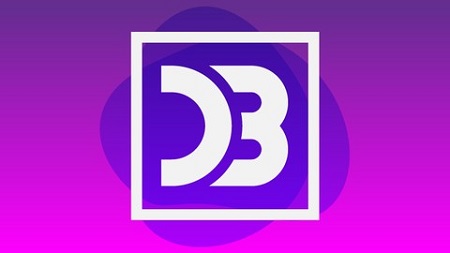
English | MP4 | AVC 1280×720 | AAC 44KHz 2ch | 92 lectures (8h 58m) | 2.89 GB
Dive deep under the hood of D3.js. Learn core concepts and build stunning data visualizations using D3 version 7
Hello! Welcome to the D3.js development course. This is the most comprehensive and effective course on D3 around. This is the only course you’ll ever need to learn D3.
The goal of this course is to not just teach you D3 (v7.x), but help you understand D3. D3 is a JavaScript library that allows you to build data visualizations easily. The library is absolutely massive and you can create any kind of data visualization you can imagine. With such a massive library, it can be difficult to grasp a lot of the concepts.
By the end of this course, you’ll be more than comfortable using D3 and build awesome visualizations. Here is just some of the things you can expect to learn.
Learn about D3 selections which are used to select and manipulate elements on your document.
Get a basic overview of SVG. This is something courses skip over. By having a solid foundation of SVG, then you can make more optimal decisions for your visualizations.
Learn about scales which help you by converting your data into values that can be used to properly display your data. We’ll learn about the linear, quantize, quantile, threshold, log, color, and a whole lot of other scales in this course.
Builds various graphs such as bar graphs, pie charts, scatter plots, histograms, line charts, and so much more!
Add interactivity and animation to your graphs to make them more interesting and appealing to the user.
Builds responsive graphs. Your visualizations will work on any device with a few simple tricks.
This course focuses on the latest version of D3. (version 7.x)
This is just some of the topics that will be covered. If you want to take ONE COURSE to learn everything you need to know to be successful D3 developer, take this course.
What you’ll learn
- Create stunning data visualizations using D3 and SVG
- Understand selections to manipulate the DOM using D3
- Learn about layouts to build various charts and graphs
- Add transitions and animations to your graphs for a more interesting user experience
- Use scales to help make your visuals work on any browser or device.
- Understand the enter and exist modes in D3
- Create responsive charts and graphs
Table of Contents
Overview
1 Overview
2 Preparing a Local Server
3 Understanding D3 & Data Visualization
Understanding SVG
4 What is SVG
5 Creating SVG images
6 Basic SVG Shapes
7 SVG Paths
Fundamentals
8 Adding D3
9 D3 Packages
10 Selections
11 Appending Elements
12 Transformation Methods
13 Classes and Styles
14 Joining Data
15 The Enter Selection
16 The Exit Selection
17 Displaying Data
18 Enter Update and Exit
19 The Update Pattern
20 JSON Requests
21 CSV Requests
Drawing A Scatterplot
22 First Steps
23 Drawing the Image
24 Adding Margins
25 Accessor Functions
26 Understanding Scales
27 Writing Scales
28 Applying Scales to Visualizations
29 Refining Scales
30 Adding an Axis
31 Refining the xaxis
32 The yaxis
33 Flipping the yaxis
34 Refining the Axis Ticks
35 Summary
Scales
36 Continuous vs Discrete
37 The scaleLinear scale
38 Introduction to Heatmaps
39 Drawing the Heatmap
40 Colors with a Linear Scale
41 The scaleQuantize Scale
42 The scaleQuantile Scale
43 The scaleThreshold Scale
44 Quantize vs Quantile vs Thresholdv
45 Color Scales
46 Understanding the Log Scale
47 The scaleLog Scale
48 Summary
Animations & Interactivity
49 Introduction to Animations & Interactivity
50 What is a histogram
51 Preparing the Histogram
52 Understanding the Problem
53 Creating Bins
54 Histogram Finishing Touches
55 Changing Metrics with Events
56 Updating the Chart
57 Transitions
58 Understanding the Problem
59 Fixing the Transition
60 Fixing the Exit Transition
61 Tweaking the Bars and Labels
62 Adding the Mean
63 Adding a Tooltip
64 Mouse Events
65 Formatting
66 Understanding the Voronoi Diagram
67 Creating a Voronoi Diagram
68 Fixing the Voronoi Diagram
Even More Charts
69 Even More Charts
70 Preparing the Line Chart
71 Time Scales & Parsing
72 Line Generator
73 Adding an Axis
74 Preparing the Tooltip
75 Understanding Bisectors
76 Custom Bisectors
77 Finishing the Tooltip
78 Getting Started with Pie Charts
79 Drawing Arcs
80 Understanding Ordinal Scales
81 Using Ordinal Scales
82 Adding Labels
83 Fixing the Pie Chart
84 Preparing the Stacked Bar Chart
85 The Stack Function
86 Band Scales
87 Drawing the Stacked Bars
88 Drawing the Axis
89 Finishing Touches
Conclusion
90 Sketching
91 Responsive Charts
92 Conclusion
Resolve the captcha to access the links!